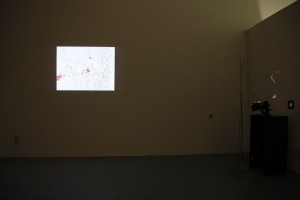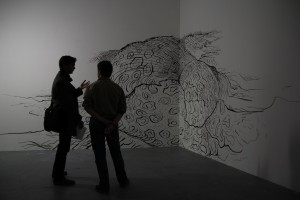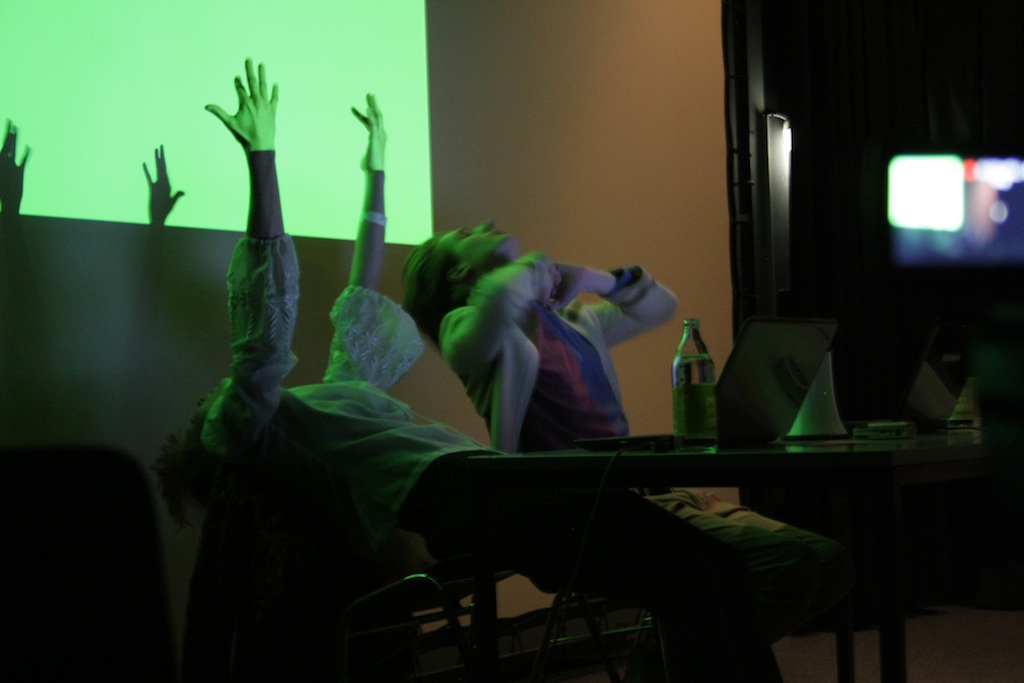das Fragment
Ausstellungseröffnung 25.04.2013
Filmstudio: Performative Lesung von Fromme Schimpansin & Arbeiter 11811
Text written by Araceli Mangione
The Fragment is a loose term chosen by the artists to describe a bridging together of realities. It can be understood as an entity and or an increment, as a piece or as a whole.
It can even exist simultaneously and independently.
The space and the works presented have been assembled and created by Martina Gromadzki (b. 1990 in Kassel, Germany) and Nicola Falco (b. 1987 in Milan, Italy) and express concepts found within different external and internal parameters, on the one hand asserting the concept “everything goes,” and on the other hand, facing constrictions from already established or pre-supposed discourses. Gromadzki and Falco bring film, drawing, painting and ins tallation together, in effect, constituting a situation between the familiar (i.e. film, patterns, materials, pictures, and techniques) and the arbitrary, (i.e. found in one’s own impulsiveness, imagination and past memories).
Looking at Gromadzki’s work, the fragility, innocence and search for understanding is made quite apparent, found in her shriveled body gesture and recorded speaking in her film, Thoughts Immersed (2013). Her works rely heavily on the internal, poetic and playful. For instance, in Gromadzki’s untitled installation, the disturbances of these inner feelings and one’s desire to place them in order are expressed in the ruffled and “just-right” placements of the hanging fabric and materials. Gromadzki’s film, for example, is composed as a collage of other finished work, putting forth the question the significance of art as an assemblage of mixed mediums.
During the art process, the artist relies on improvisation and fully conscious decisions, which contribute fully to the end result made within its space of creation, within a specific, right-moment. She privatizes her work with impulsive reflections and exact decision-making. These contribute absolutely to the process of her work, but are they still relevant to the end product. The question remains of whether the end result, seen as a final moment captivating other moments, ultimately discredits those single moments or enhances them? Or perhaps they simply remain what they are, fragments.
Falco’s work can be read similarly, from the outer spectrum in and vice-versa, also posing questions of inclusion and exclusion. He replaces “truth” with a personal touch, aided by those memories of maps or grids already imprinted in his mind. The “truth” in this case, reflects that which is trusted and believed to be the truth, such as a map is used to orientate oneself within a city, country, etc. without stopping to think about questioning its actuality. Falco takes the faith entrusted in “official” information, such as a map, and confronts its authority with invalid, unofficial, self-rendered (mystical) qualities. The imaginative, self-defining city-blocks, hills, pathways, etc. of Abstract Landscape (2013) and Falco’s untitled film installation have been exercised and designed from collected experiences of map-making or simply taken from forms which resemble maps. Falco’s work emerges from an interest in systematic mapping—filled with patterns, shapes, forms, lines and curve —which tend to remain strongly embossed in his mind. As a landscape artist and film-maker, Falco reinvents the concept of map-making by extracting already set examples, either within his mind or found within the surface of an object (i.e. a rigged wall), and lets his imagination run wild. Although the featured works have been sculpted after a specific identity and rationality, the finished products remain flexible and can be shared and understood by others. Meaning, Gromadzki’s and Falco’s displays are not to be limited to the artists’ private sphere. The human, as observer, is expected and urged to find his or her own complexities, fantasies, creations and references in these works. Simply start at one point and slowly visualize the next, allowing the works to take on their
own shape and story.
Performance Fromme Schimpansin und Arbeiter 11811


